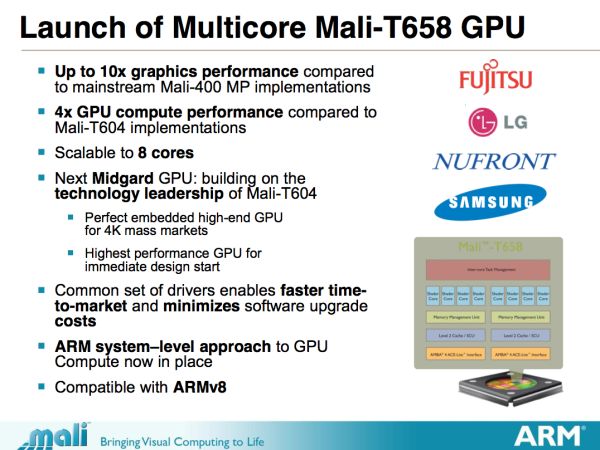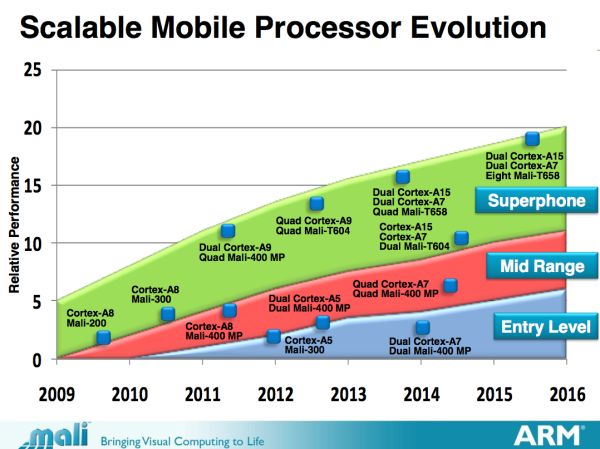ARM's Mali-T658 GPU in 2013, Up to 10x Faster than Mali-400
by Anand Lal Shimpi on November 9, 2011 8:30 PM ESTARM's licensed CPU cores dominate the mobile space. This year the core of choice for high-end smartphones and tablets is ARM's Cortex A9 and late next year it'll be the Cortex A15. ARM also offers GPU cores to its partners, although we've seen far more limited adoption compared to its CPU offerings. The limited adoption has nothing to do with a lack of performance though as we found in our review of Samsung's Galaxy S 2. ARM's Mali-400 MP4 is the fastest GPU we've tested on Android and second to only Imagination Technologies' PowerVR SGX 543MP2 across all of our mobile data.
The Mali-400, like NVIDIA's GeForce used in Tegra 2/3, doesn't feature a unified shader architecture - it has discrete pixel and vertex shader hardware. The Mali-400 is the last implementation of what ARM calls its Utgard architecture. Next year we'll see the Mali-400's successor: the Mali-T604.
The Mali-T604 was announced last year and it's the first implementation of ARM's new Midgard architecture. The T604 appears to be ARM's first unified shader architecture. Each T604 core is a combination of two arithmetic pipes and one texture pipe, although the width and capabilities of each are unknown. Like the Mali-400, the Mali-T604 will be available in 1 - 4 core configurations. The first T604 based SoCs will be available in the second half of 2012 on 28/32nm silicon. ARM is promising up to 68 GFLOPS of compute from T604 (presumably that's for a 4-core configuration at high clocks).
What comes after T604? ARM's Mali-T658 of course.
The T658 is a second generation Midgard implementation with twice the arithmetic pipes per core compared to the T604. ARM also enables up to 8-core configurations with T658. We'll see the first T658 implementations on 28/32nm sometime in 2013. It's unclear what other architectural changes have been made compared to the T604, but at bare minimum we can hope for a doubling of execution resources. ARM is promising up to a 10x increase in performance compared to "mainstream" Mali-400 implementations (perhaps single-core Mali-400).
Samsung is listed as a launch partner for Mali-T658, which isn't surprising given the company's use of Mali-400 in its Exynos 4210 (the SoC inside many of the Galaxy S 2s).
It's good to see ARM continue the evolution of its Mali graphics cores. Unlike in the PC market, there's almost no coupling between CPU and GPU IP providers in the mobile SoC space. ARM hopes to change that by offering very compelling GPUs in addition to its widely used CPUs cores. Since everything is already on a single chip however, it's unclear whether the mobile market will follow the same path - at least in the near term. The Mali-T604 and T658 will have their work cut out for them. There are new GPUs from Imagination, NVIDIA and Qualcomm that will be out over the next two years as well.

















21 Comments
View All Comments
Meaker10 - Thursday, November 10, 2011 - link
There are three major factors why they dont scale them up.1. Power consumption
2. Chip size and yield
3. Bandwidth limitations
3 is a kicker, you can scale it up, but with the current memory bandwidth its not going to help.
tipoo - Wednesday, December 7, 2011 - link
They also wouldn't be limited to low power DDR RAM in a console though, they could use XDR2 RAM or DDR5 with a wide bus, etc.iwod - Wednesday, November 9, 2011 - link
I am more interested in PowerVR RX and the 6 Series..dagamer34 - Wednesday, November 9, 2011 - link
I can't wait until ARM SoCs literally power every electronics device imaginable. No more crappy, low frame rate devices but fast, fluid interfaces limited only by what our minds can think of.Basically, someone PLEASE make a high end car stereo worth owning!!! Theres no reason I should have to pay $1000 for a touchscreen and UI from 1999! Ridiculous!
juhatus - Thursday, November 10, 2011 - link
What hit me in the eye was"Perfect embedded high-end GPU for 4k mass markets"
Are we gonna finally start to see devices for 4k x 2k resolution?
Any comments, Anand? :)
Guspaz - Thursday, November 10, 2011 - link
Well, not smartphones or tablets, no. iPad 3 is expected to use a 2048*1536 display, and pixel densities much higher than that on a 10" screen don't really make any sense. In fact, there isn't much point increasing resolution much more than we're already seeing now on smartphones, because there isn't any benefit to scaling it higher (it's already better than we can resolve with our eyes).A similar argument can be made for televisions; yes, they're much larger, but you're sitting a lot farther away. Larger sizes might see a benefit, but even 1080p (or 2K, if you will) is probably overkill at 32" or lower. On the other hand, a large display (46", 55", etc) would probably see a benefit from 4K.
A more interesting place for improvements would be desktop displays, IMO. The problem is that no modern desktop OS is resolution agnostic. Smartphones and tablets have already gone that way, because you can't make UI elements any smaller and still expect fingers to be able to accurately touch them, but Windows/OS X/Linux/etc all have poor or non-existent resolution-independent support.
ajp_anton - Thursday, November 10, 2011 - link
If they compare single-core 400 with an 8-core T658, a 10x increase in performance doesn't sound very good...CityBlue - Thursday, November 10, 2011 - link
Is that they are completely open source compatible, none of the NDA bullsh1t you get with PowerVR implementations.Imagination Technologies, through their PowerVR designs, are thoroughly hostile towards the open source community, whereas ARM are the complete opposite.
The sooner PowerVR GPUs disappear from all future ARM SoCs the better, and my guess is that this will start to happen sooner than later as it becomes a no brainer to use ARM Mali IP rather than deal with the hostile and difficult Imagination Technologies, and their separately licensed (and perhaps more expensive while also less flexible) PowerVR IP.
Goodbye Imagination Technologies, and good riddance.
geniekid - Thursday, November 10, 2011 - link
I don't know about that. Posted on AT the same day as your comment:http://www.anandtech.com/show/5083/samsung-license...
You may very well be right about Imagination Technologies and their hostile attitude, but they will probably be sticking around at least a little bit longer.
CityBlue - Thursday, November 10, 2011 - link
Hopefully that's just to keep Apple happy.For everyone else, and their own hardware and software, fingers crossed they'll use switch to Mali.
I'll be dismayed if Samsung start shipping Tizen handsets based on PowerVR SoCs.